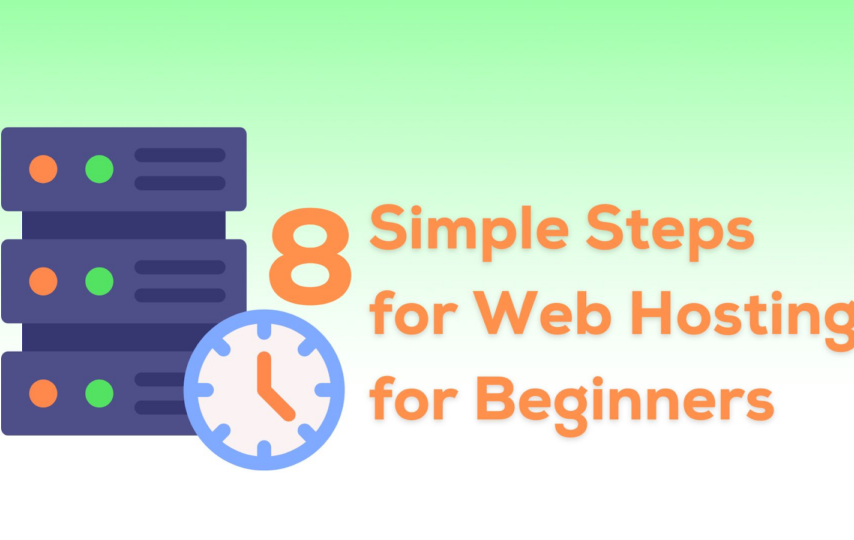In today’s digital era, we know that having a strong online presence is essential for businesses and individuals looking to gain traction. When it comes to your company’s web you need to concentrate on running your website with well thought out user interface and design. You need to understand the concept of web designing, why it’s needed, and how to choose website hosting.
If we get clarity on this aspect, we can manage the rest of the web hosting process with minimal difficulty. In this article, we have explored the simple steps of web hosting as a beginner. We’ve also provided you with all the things you need to know and how to make them.
Understanding Web Hosting
Web hosting is an online service that makes your website’s content accessible on the internet. When you purchase a hosting plan, you are renting space on a physical server to store all the website’s files and data.
This server makes your website accessible to visitors who type in your domain name in their web browsers. Many web hosting companies provide you with the infrastructure and services necessary to ensure your website is live and accessible 24/7.
Step 1: Determine Your Hosting Needs
The first step in the web hosting journey is to identify your specific hosting requirements. Different types of websites have different needs, and understanding your goals will help you choose the right hosting service.
Are you planning to create a small personal blog or a large e-commerce platform? Here are some common types of web hosting to consider:
- Shared Hosting:
Ideal for beginners and small websites. Your website shares server resources with other websites, making it cost-effective but with potential limitations in performance.
- VPS (Virtual Private Server) Hosting:
Provides a dedicated portion of a server’s resources, offering additional control and performance when compared to shared hosting.
- Dedicated Hosting:
You get an entire server to yourself, offering maximum performance and control. It’s suitable for large websites with high traffic.
- Cloud Hosting:
Your website’s resources are distributed across multiple servers, providing scalability and resilience. For these reasons, cloud hosting is a good option for growing websites.
Step 2: Research Web Hosting Companies
Hosting is important, but it is always vital that you research web hosting companies. With the range of options available, picking one can seem challenging. Each web hosting company has its own set of features, pricing, and customer reviews.
We have explored some aspects that you’ll need to pay attention to when evaluating web hosting providers.
- Reliability and Uptime:
Ensure that your website is easily accessible to all visitors at all times without any problems. Make sure you choose a company with a strong track record of uptime and with as minimal issues as possible.
- Customer Support:
It’s essential and crucial to do 24/7 customer support. Always search for a host that provides you with responsive and helpful customer care in case you encounter any issues.
- Scalability:
If you come to know that your website is consistently growing over time, you should consider a host that offers you easy scalability to accommodate increased traffic and resources.
- Security Features:
When it comes to the web it’s always not safe nowadays. So you make your website safe. Look for hosts that provide SSL certificates, regular backups, and security measures to protect your data.
- Price and Plans:
Cross-checking and comparing the pricing and plans of different hosting providers is essential. Make sure you opt for affordability as the cost is important, but you’ll need to ensure that’s not the sole deciding factor for your decision.
Step 3: Compare Web Hosting Services
If you shortlisted a few web hosting companies then make a note of comparisons on their services in detail. And also pay attention to the following factors during your comparison. This will make you know more about web hosting.
- Features:
Always make checks for features offered in each hosting plan. Does it include a free domain, email accounts, website builders, and one-click installations of popular platforms like WordPress?
- Performance:
Look for hosting providers that use solid-state drives (SSDs) for faster loading times. High-speed performance is crucial for user experience and search engine ranking.
- Control Panel:
A user-friendly control panel, such as cPanel, makes it easier to manage your website, domains, and settings.
- Scalability Options:
If your website grows, can you easily upgrade your plan or add resources without major disruptions?
- Data Backup and Security:
Automatic backups and robust security features protect your website’s data and visitor information.
Step 4: Select the Best Web Hosting Provider
Selection of the best web hosting provider is based on your research and comparisons. You need to narrow down your choices and select the web hosting provider which provides you with the best for your needs.
Always remember, the best provider is one who meets your current requirements and can be flexible to accommodate your future growth.
You need to see all the pros and cons before settling on the provider. This might change the whole part if you were wrong. Always explore more and compare before settling into one web hosting provider.
Step 5: Sign Up and Set Up Your Website
Right after choosing a web hosting company, you must be aware of the next step. It is domain registering if needed and signing up for a hosting plan.
Many hosting providers offer wizards and installation guides. It walks through the process of setting up your website.
If you are using a popular platform like WordPress, you may benefit from one-click installations. These kinds of setups make it even easier than we think. So it is important to sign up and set up a proper hosting plan for your website.
Step 6: Design Your Website
We know that designing is an essential thing nowadays. When designing a website, we need to design our website to be ranked in domain place. When it comes to designing your website you can choose from various website builders, you can even hire a web designer to create a customized look based on your preferences.
Keep focussed on creating a user-friendly, visually appealing. This aligns your idea with your brand’s content. It’s always better to make a custom look with unique patterns which will be more helpful to reach out.
Step 7: Regular Maintenance and Updates
If launching your website is over, and you have completed all the processes mentioned above you need to do regular maintenance, updates, and content creation. You might think it is not necessary but it is essential to keep your website fresh and engaging. Only regularly updating plugins, changing themes to the current situation, and making your content management system ensure optimal security and performance.
Step 8: Consider Future Needs
A final step to ensure your website gains traction and to know your goals get achieved, you need a change in hosting. Assess your hosting requirements periodically and always make necessary upgrades to get increased traffic and demand.
Conclusion
By understanding your hosting needs, researching web hosting companies, and making informed comparisons, you can select the best web hosting provider for your website.
Once you’ve gone through the steps mentioned above, you’ll be ready to publish your site live on the web. You can start building your landing pages, populating your site with content, writing blogs, and everything else that comes along with running a website.








